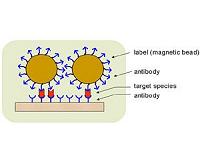 |
Nashville, TN (SPX) Apr 29, 2011 It's common knowledge that the perfect is the enemy of the good, but in the nanoscale world, perfection can act as the enemy of the best. In the workaday world, engineers and scientists go to great lengths to make the devices we use as perfect as possible. When we flip on a light switch or turn the key on the car, we expect the lights to come on and the engine to start every time, with only rare exceptions. They have done so by using a top-down design process combined with the application of large amounts of energy to increase reliability by suppressing natural variability. However, this brute-force approach will not work in the nanoscale world that scientists are beginning to probe in the search for new electrical and mechanical devices. That is because objects at this scale behave in a fundamentally different fashion than larger-scale objects, argue Peter Cummings, John R. Hall Professor Chemical Engineering at Vanderbilt University, and Michael Simpson, professor of materials science and engineering at University of Tennessee, Knoxville, in an article in the April issue of the ACS Nano journal.
Noise makes a difference Nature, however, has managed to figure out how to put these fluctuations to work, allowing living organisms to operate reliably and far more efficiently than comparable man-made devices. It has done so by exploiting the contrarian behavior that random behavior allows. "Contrarian investing is one strategy for winning in the stock market," Cummings said, "but it may also be a fundamental feature of all natural processes and holds the key to many diverse phenomena, including the ability of the human immunodeficiency virus to withstand modern medicines." In their paper, Cummings and Simpson maintain that in any given population, random fluctuations - the "noise" - cause a small minority to act in a fashion contrary to the majority and can help the group respond to changing conditions. In this fashion, less perfection can actually be good for the whole.
Mimicking cells "Instead of trying to make perfect decisions based on imperfect information, the cell plays the odds with an important twist: it hedges its bets. Sure, most of the cells will place bets on the likely winner, but an important few will put their money on the long shot," Simpson said. "That is the lesson of nature, where a humble bacterial cell outperforms our best computer chips by a factor of 100 million, and it does this in part by being less than perfect." Following the lead of nature means understanding the role of chance. For example, in the AIDS virus, most infected cells are forced to produce new viruses that infect other cells. But a few of the infected cells flip the virus into a dormant state that escapes detection. "Like ticking bombs, these dormant infections can become active sometime later, and it is these contrarian events that are the main factor preventing the eradication of AIDS," Simpson said. "Our technology has fought against this chance using a brute force approach that consumes a lot of power," Cummings said. As a result, one of the factors limiting the building of more powerful computers is the grid-busting amount of energy they require. Yet residing atop the cabinets of these supercomputers, basking in the heat generated in the fight to suppress the element of chance, the lowly bacteria show us another way. Cummings and Simpson conduct research at the Department of Energy's Center for Nanophase Materials Sciences at Oak Ridge National Laboratory. CNMS is one of five national DOE Nanoscale Science Research Centers.
Share This Article With Planet Earth
Related Links Vanderbilt University Nano Technology News From SpaceMart.com Computer Chip Architecture, Technology and Manufacture
 New nanobead approach could revolutionize sensor technology
New nanobead approach could revolutionize sensor technologyCorvallis OR (SPX) Apr 27, 2011 Researchers at Oregon State University have found a way to use magnetic "nanobeads" to help detect chemical and biological agents, with possible applications in everything from bioterrorism to medical diagnostics, environmental monitoring or even water and food safety. When fully developed as a hand-held, portable sensor, like something you might see in a science fiction movie, it will pro ... read more |
|
| The content herein, unless otherwise known to be public domain, are Copyright 1995-2010 - SpaceDaily. AFP and UPI Wire Stories are copyright Agence France-Presse and United Press International. ESA Portal Reports are copyright European Space Agency. All NASA sourced material is public domain. Additional copyrights may apply in whole or part to other bona fide parties. Advertising does not imply endorsement,agreement or approval of any opinions, statements or information provided by SpaceDaily on any Web page published or hosted by SpaceDaily. Privacy Statement |